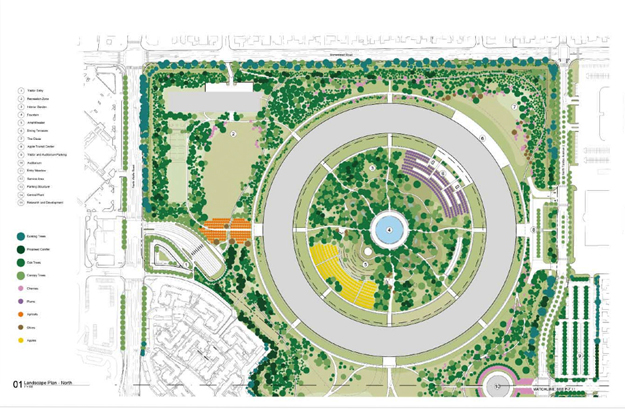
Designed by Foster and Partners, the new Apple headquarters in Silicon Valley will feature a giant donut-shaped structure. Recent plans also show ample fruit trees on the 175-acre campus, meant to recall the area's agricultural heritage.
Image courtesy City of Cupertino
When he described his childhood in California’s Santa Clara (now Silicon) Valley, Steve Jobs often mentioned the apricot orchards that made the area a kind of earthly paradise. So it’s fitting that one of the first things visitors will see at Apple’s new headquarters—the circular building designed by Foster and Partners on a 175-acre site in Cupertino—is an apricot grove.
That’s clear from plans filed last month with the city of Cupertino, and stamped by both Foster and Olin Partnership, the Philadelphia-based landscape architecture firm. The apricot orchard, which in previous submissions to the city had been hidden from view, is now front-and-center at the entrance to the Apple Campus, where some ten lanes of traffic will descend into underground parking lots. Principal Laurie Olin declined to speak about the headquarters, citing a nondisclosure agreement. But Apple’s latest submission to Cupertino states that “the landscape design will recall Cupertino’s pre-agricultural and agricultural past”—clearly Jobs’s dream.
He revised plans show that Olin has given the Foster building a more naturalistic setting since previous submissions last year, with meandering paths added to the vast courtyard inside the torus, amid reconfigured apple and plum orchards. At the same time, the main entrance to the campus has moved away from an existing intersection, further isolating the campus from its neighborhood.
But the big news isn’t about fruit trees and traffic patterns: It’s that the entire project didn’t die with Jobs. The Foster building, meant to house 14,000 workers, was a pet project of the Apple chief, who unveiled the plans last June during one of his final public appearances. His successors have been deterred neither by his death in October nor by withering criticism of the building, a 2.8 million-square-foot donut almost a mile in circumference. Writing in The New Yorker, Paul Goldberger, described its geometric rigidity to that of the Pentagon and said it would be a shame if Jobs’s last contribution was his least meaningful. Los Angeles Times architecture critic Christopher Hawthorne called the project a “retrograde cocoon.”
Clog, an experimental architecture journal, devoted its entire February issue to Apple’s architecture. It included some strong language. Sanford Kwinter called the campus plan “barbarism” and Mark Wigley delivered perhaps the ultimate dig: “It is hard to think of a more analog building.” Kyle May, the editor in chief of Clog, said he is “surprised that the project is moving forward, given all the criticism from the architecture community.” (Clog’s Apple issue will be celebrated in a show on “Archizines” opening tonight at New York’s Storefront for Art and Architecture).
Apple’s decision to proceed is good news for Norman Foster, and not just because of the vast budget. The association with Apple—known not only for superb product design but also for the first-rate architecture of its retail stores (by Bohlin Cywinski Jackson)—can only burnish his reputation, even if few people ever get to see the building. And few will. As Apple states in its latest submission to the city, in preparation for an environmental impact assessment, one of its objectives is to “achieve the security and privacy required for the invention of new products by eliminating any public access to the site, and protecting the perimeters against trespassers.” Apple has always been secretive, but the language is jarring in an era when urban planning tends to be about creating, not curtailing, interaction.
The documents are replete with mentions of green features, including rooftop solar panels. But it’s hard to imagine anything less green than tearing down dozens of existing structures, totaling some 2.65 million square feet, to make way for a new building of almost the same size. That hardly jibes with Jobs’s view of a natural paradise in the Silicon Valley.



Post a comment to this article
Report Abusive Comment